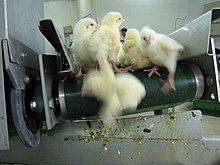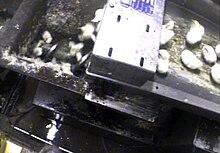

Chick culling or unwanted chick killing is the process of separating and killing unwanted (male and unhealthy female) chicks for which the intensive animal farming industry has no use. It occurs in all industrialised egg production, whether free range, organic, or battery cage. However, some certified pasture-raised egg farms are taking steps to eliminate the practice entirely.[1][2] Worldwide, around 7 billion male chicks are culled each year in the egg industry.[3] Because male chickens do not lay eggs and only those in breeding programmes are required to fertilise eggs, they are considered redundant to the egg-laying industry and are usually killed shortly after being sexed, which occurs just days after they are conceived or after they hatch.[3] Some methods of culling that do not involve anaesthetics include: cervical dislocation, asphyxiation by carbon dioxide, and maceration using a high-speed grinder. Maceration is the primary method in the United States. Maceration is often a preferred method over carbon dioxide asphyxiation in western countries as it is often considered as "more humane" due to the deaths occurring immediately or within a second.[4][5]
Due to modern selective breeding, laying hen strains differ from meat production strains (broilers). In the United States, males are culled in egg production because males "don't lay eggs or grow large enough to become broilers."[4]
Ducklings and goslings are also culled in the production of foie gras. However, because males gain more weight than females in this production system, the females are culled, sometimes in an industrial macerator.[6] The remains of female ducklings are later used in cat food and fertilisers.[7] In total, around 4-7 billion male chicks and up to 40 million female ducks per year may be killed in this way.[3]
Because of animal welfare concerns, there is societal opposition to chick culling. In the 2010s, scientists developed technologies to determine the sexes of chicks when they are still in their eggs (in-ovo sexing). Germany and France jointly became the first countries in the world to prohibit all chick killing from 1 January 2022, and called on other EU member states to do the same.[8] Italy also banned the practice soon after.[9]
- ^ "Lay Thee Down To Rest". Vital Farms. Archived from the original on 2022-06-20. Retrieved 2022-06-21.
- ^ Brulliard, Karin (October 27, 2016). "New technique may prevent the gruesome deaths of billions of male chicks". The Washington Post. Retrieved June 20, 2022.
- ^ a b c Krautwald Junghanns, ME; Cramer, K; Fischer, B; Förster, A; Galli, R; Kremer, F; Mapesa, EU; Meissner, S; Preisinger, R; Preusse, G; Schnabel, C; Steiner, G; Bartels, T (1 March 2018). "Current approaches to avoid the culling of day-old male chicks in the layer industry, with special reference to spectroscopic methods". Poultry Science. 97 (3): 749–757. doi:10.3382/ps/pex389. PMID 29294120.
- ^ a b Blakemore, Erin (2016-06-13). "Egg Producers Pledge More Humane Fate for Male Chicks". Smithsonian. Retrieved 22 April 2024.
- ^ "What happens with male chicks in the egg industry?". RSPCA Knowledgebase. RSPCA Australia. 22 September 2021. Retrieved 22 April 2024.
- ^ Rodenburg, T. B.; Bracke, M. B. M.; Berk, J.; Cooper, J.; Faure, J. M.; Guémené, D.; Guy, G.; Harlander, A.; Jones, T. (December 2005). "Welfare of ducks in European duck husbandry systems". World's Poultry Science Journal. 61 (4): 633–646. doi:10.1079/WPS200575. ISSN 1743-4777. S2CID 1206732.
- ^ Hughes, I. (2014). "Shocking video shows hundreds of live ducklings 'thrown into mincer' on cruel 'foie gras farm'". The Mirror. Retrieved March 14, 2015.
- ^ Cite error: The named reference
Dahmwas invoked but never defined (see the help page). - ^ "Italy moves forward with ban on selective culling of male chicks". eurogroupforanimals.org. 2021-12-21. Retrieved 2023-08-30.